Measuring employee experience (EX) is a hot HR topic these days with many companies looking into improving their EX, hence boosting the productivity of their staff, lowering employee turnover, and improving customer satisfaction.
How to measure employee experience?
According to one of the most prominent researchers in the employee experience space Jacob Morgan, employee experience can be broken down into three domains:
- The physical space
- Workplace technology
- Company culture
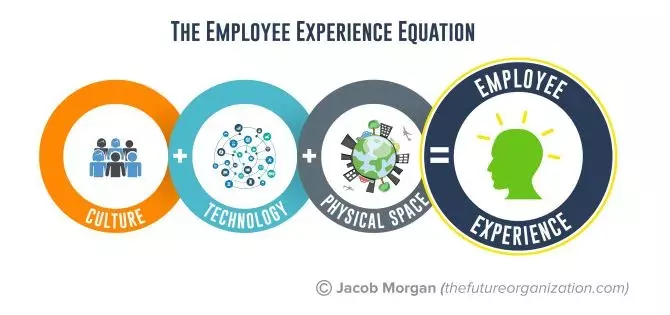
Hence, measuring employee experience comes down to accessing how satisfied your employees are with the actual spaces they use for work, with the tools they use to get their job done, and with the overall feeling, they get from working at your organization.
While it might sound simple on paper, many companies are struggling with getting a realistic picture of how their employees are feeling about their workplace. Below are some techniques to help you measure the employee experience.
📚 Related: Employee Engagement Guide
1. Employee experience surveys
This is the most common technique of collecting employee feedback these days. Surveys enable collecting easy-to-analyze and easy-to-act-on feedback from a large number of employees at once.
Moreover, surveys allow you to get a grasp of the employee experience of those remote and frontline workers that might not be in direct contact with their supervisors on a daily basis due to different locations and shift schedules. Modern employee apps are able to gather feedback also on mobile, which makes it easy to gather information even from those employees who don’t have access to email.
Below are the most common types of employee experience surveys:
Employee engagement surveys
Employee engagement is the emotional connection an employee feels towards their organization, that influences their behaviors and level of effort in work-related activities.
The main objective of these surveys is to evaluate how motivated and engaged your employees are at work. They measure how dedicated your employees are to their company, management, and colleagues; and are typically conducted annually. These surveys are likely to include questions around the following subjects:
- Organizational strategy
- Culture and values
- Senior leadership
- Thoughts – what they think about their work, colleagues, and management
- Feelings – emotive aspects such as pride in the organization
- Behaviour – intention to stay and advocacy
- Pay & benefits.
📙 Also read: 12 Talent Management (TM) Tips for Navigating Turbulent Times.
Pulse survey
As opposed to the engagement surveys, pulse surveys are short (5-15 minutes) and are typically done more frequently (most organizations arrange these quarterly or monthly). These surveys also track the same construct over time, so the results are easy to compare against each other and it is easier to link changes in employees’ answers to changes within the organization.
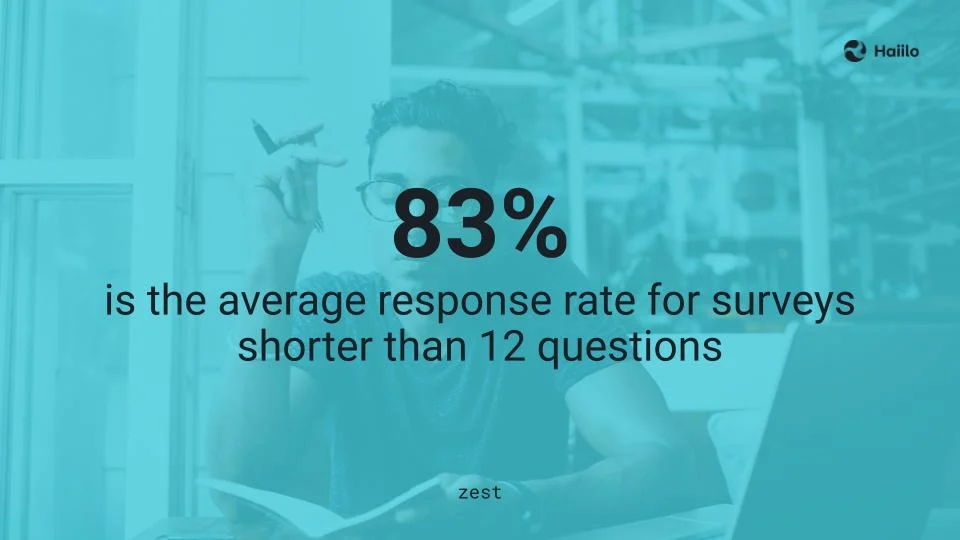
A pulse survey often measures the Net Promoter Score (NPS). This question is typically formulated as follows: “How likely is it that you would recommend [Organisation X/Product Y/Service Z] to a friend or colleague?” and the respondent is given an option to rate the likelihood from 0 to 10.
📚 Also learn about how to boost employee morale during the pandemic.
Candidate Feedback Survey
Applying for the job is the 1st interaction your employees have with the company, which directly affects not just the employee experience but also the company’s employer brand.
This type of survey is normally gathered among the candidates that have attended a job interview in your company, those who have reached the final stages, and the new hires. The survey is typically anonymous.
Candidate feedback surveys would typically evaluate the overall experience from the interview process, the clarity of the job description (and its consistency throughout the stages of recruitment), the efficiency of phone and email communication, and possible suggestions for improvements.
📚 Also learn about the 9 Ways to Combat Employee Turnover
Onboarding Survey
The onboarding process is a crucial stage in the employee lifecycle. It directly affects the perception of the company a new hire builds and their willingness to continue their career at your company also after their trial period has ended. These interviews are usually non-anonymous, so that the new hire’s manager can be made aware of the interview results.
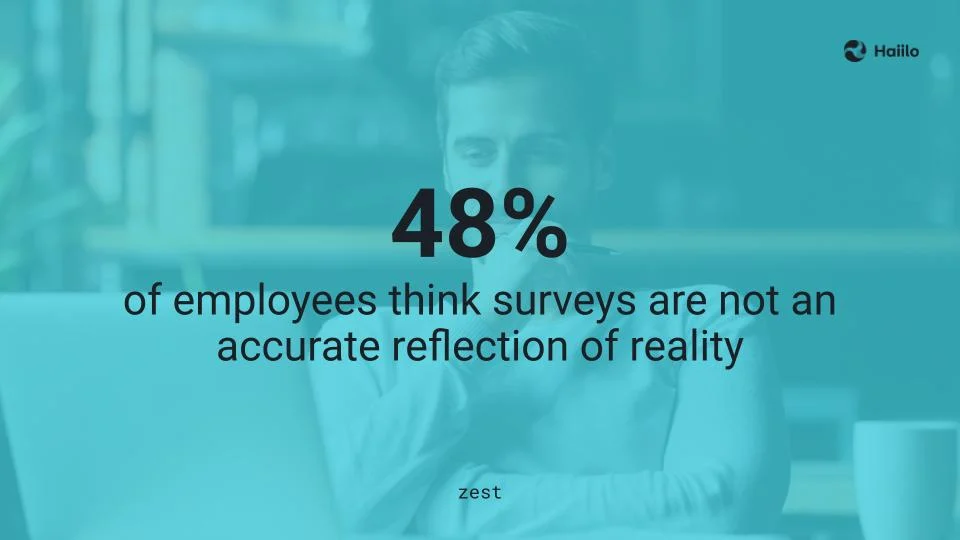
Onboarding interviews evaluate the quality of the onboarding process, the overall perception the new hire has of the company. After the interview is completed the new employee and their manager can discuss the results of it and develop an action plan based on that to ensure all possible areas of improvement are addressed and the employee feels welcomed at the new place.
📚 Also learn about how to build a positive workplace culture in your organization.
Exit Survey
As is clear from the name, these surveys are arranged for those employees that are planning to leave the company. They are often replaced by exit interviews so that the managers can get even more insight into the reasons the employee is leaving and their suggestions on improving the work.
If you decide to go for an exit survey instead of an exit interview, make sure to include questions about the overall experience the employee has had at the workplace, their assessment of what was done well and what could be improved in the workplace, and their suggestions on what could be done to increase retention in the future.
💡 Also learn about what are employee engagement apps and why every organization needs one.
2. Focus groups
Another common way of measuring employee experience is by arranging focus groups. While employee surveys are a good way to get quantitative data, a focus group can help management enrich this data by getting more in-depth information on how employees feel about particular events in the organization.
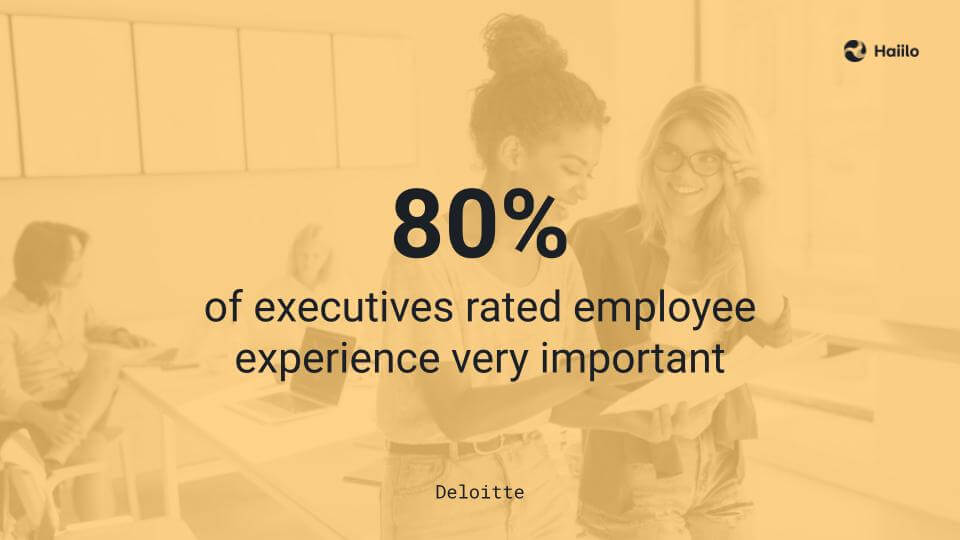
Moreover, focus groups give employees a platform to elaborate on their improvement suggestions for processes in your organization and develop tangible action steps on how to improve their employee experience.
Focus groups are often arranged to check employees’ pulse following a major change in the company. In some companies, however, employee focus groups are held instead of surveys and are done regularly.
It is important to follow a specific procedure when conducting an employee focus group in order to gather actionable results. It is not enough to just gather a group of employees and have a discussion. Each focus group should have a dedicated moderator – an authoritative person respected and trusted by the employees.
Quite often direct managers are excluded from the focus groups altogether in order to achieve more objective results. Another important role in every focus group is a coordinator – someone responsible for taking detailed notes and arranging the logistics of the meeting. Lastly, the most important participants of a focus group are the employees: normally a focus group will include 6 to 12 participants.
Depending on the subject and the objective of the focus group, employees might be chosen randomly or based on other factors. In any case, a good representation of the affected population is the goal.
Make sure to study the process of preparing for and running a focus group before you arrange it.
3. Look at the data you already have
While it’s always good to ask employees for open feedback, it’s also beneficial to look at the data you have readily available to help you evaluate the employee experience. Below are some examples of the information you could look at to help you understand how satisfied your employees are with their jobs:
- Employee turnover: while it is healthy to have employee turnover in any business, it is a good idea to try and look for data on employee turnover at organizations of similar size within a similar industry. If you notice that your employees tend to stick around for much less than those of peer organizations, it is a clear sign of poor employee experience.
- Employee referrals: while employees can sometimes be reluctant to give open feedback to their employees, a lack of employee referrals for open positions can signify that they are unhappy with their experience. We all want what is best for our friends, so employees are unlikely to refer your organization to their close ones if they are unhappy there.
- Customer satisfaction: it has been proven that companies that have high customer satisfaction rates have 1.5 times more engaged employees. And there is no surprise there: happy people perform better at their work than those who are not satisfied with their work environment. This is why getting data from your customers on how happy they are with the service they get can help get a better understanding of the employee experience at your organization.
- Promotions from within and lateral moves: it is good for the employees to hear that there are growth and development opportunities within their company, but it is much better to help them see that. So the data on what percentage of your employees have had the opportunity to grow within the company can give you very straightforward information on what employee experience your people have in the workplace.
Why is it hard to measure employee experience
Employee experience is a complicated framework, and measuring EX is not easy to do. The main reason for that is that there are many different factors shaping employee emperience at work. According to Josh Bersin’s employee experience guide, employee experience gets shapred by: meaningful work, strong management, positive workplace culture, growth opportunities, organizational trust and employee health and wellbeing.
For employee experience to be optimal, it is important to achieve the right balance with all these factors. For example, you can’t just offer growth opportunities and hope that your employees are happy. Instead, it’s important that you address all the other factors such as workplace culture and strong leadership.
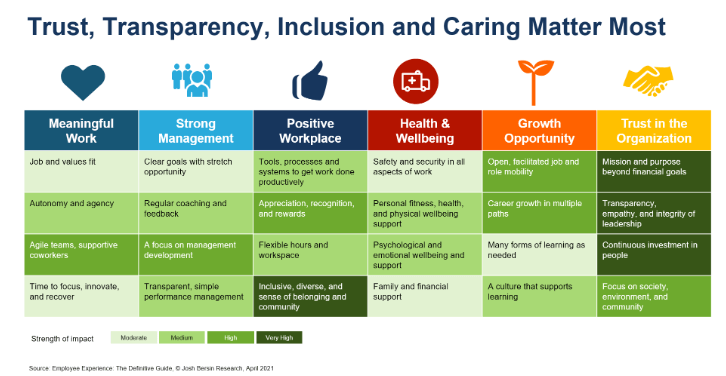
It’s important to measure all of these employee experience factors individually and understand what motivates your people. Also, know that one size doesn’t fit all. Your employees in IT department may not be motivated by the same things as people in HR department. So providing personalized experience at work is also critical.
Once you get insights about what your people care about, you can undertake a number of different initiatives such as employee recognition programs, wellbeing programs, leadership trainings, and various internal communication campaigns.
📹 Also, check out Masterclass: Strategies for Driving Employee Engagement in the Workplace
Tools to help you measure and boost employee experience
There are many tools that can help you gather feedback from your employees on their experience with your company. Modern employee communications software, such as Haiilo, is able to do that all while helping you boost your employee engagement by keeping all employees informed and engaged with your company updates and aligned with your core company values.
Employee experience platforms are designed to help you find the most important factors impacting your employees’ experience at work and get insights from employees about how to improve them. For example, using simple pulse surveys, you can find out whether your employees are motivated mostly by compensation and benefits or other things such as meaningful recognition. Based on the insights, you can consider implementing an employee recognition program to boost your employees’ experience, motivation and engagement.
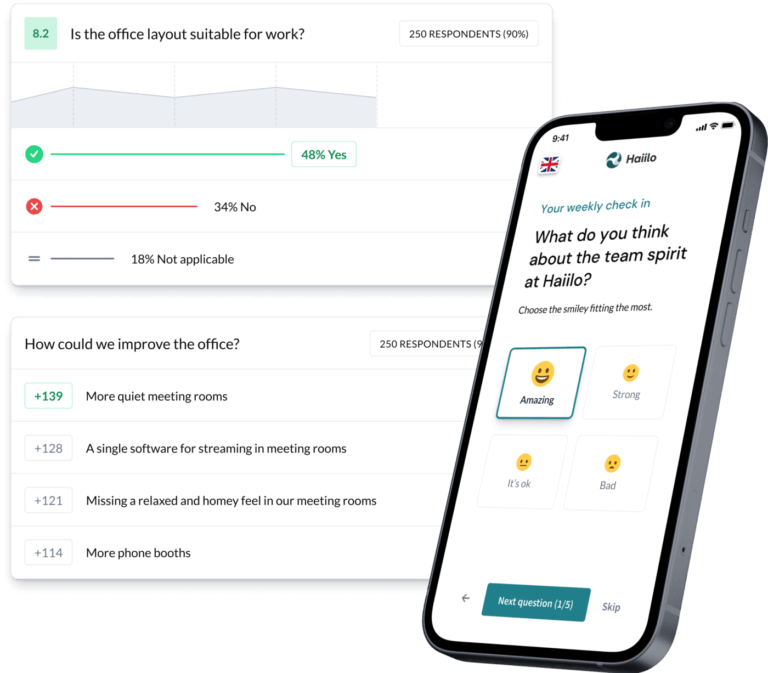
Measuring employee experience can be a tall order for many organizations. This is why modern employee apps have built-in surveys to help you gather feedback from employees on how they feel at work.
Tools like Haiilo can help you to measure and improve your employee experience at your company by reducing information overload for your corporate workers and keeping your frontline workers up-to-date with what is happening in your organization. Book a 15-minute call with us to see how we can help you on your journey towards a better employee experience.









